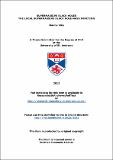Files in this item
Supermassive black holes : the local supermassive black hole mass function
Item metadata
| dc.contributor.advisor | Driver, Simon Peter | |
| dc.contributor.author | Vika, Marina | |
| dc.coverage.spatial | 160 | en_US |
| dc.date.accessioned | 2012-04-12T14:56:58Z | |
| dc.date.available | 2012-04-12T14:56:58Z | |
| dc.date.issued | 2012-06 | |
| dc.identifier.uri | https://hdl.handle.net/10023/2553 | |
| dc.description.abstract | Over recent years there has been an increase of the number of secure supermassive black hole (SMBH) detections. These SMBH measurements have lead astronomers to establish well defined empirical relationships between the SMBH mass and some of the properties of the host galaxy. The number of galaxies with SMBH mass measurements is currently limited to about 100. One approach of expanding the study of the SMBH is to use the empirical relations for estimating M[subscript(bh)] for larger samples of galaxies. The investigation of the SMBH population (or SMBH mass function) for large sample of galaxies in the nearby universe has helped to constrain the SMBH and the galaxy evolution. Previous estimates of the SMBH mass function at low redshift were produced mainly by combining the measurements of the galaxy luminosity or velocity function with one of the SMBH scaling relations. In the first part of the thesis I will present an independent construction of the nearby supermassive black hole mass function by applying the optical M[subscript(bh)]–L relation onto the Millennium Galaxy Catalogue (MGC). Additionally, in the second part I will provide photometric analysis of all UKIDSS galaxies for which SMBH masses have been measured. I will derive composite profiles of brightness, ellipticity and position angles of each galaxy. I will show that the Sérsic function fits the brightness profile of the majority of the elliptical galaxies and the bulge of disk galaxies and I will provide alternative multi-component fits when necessary. Then these photometric parameters will be used for constructing the M[subscript(bh)]–L relation in the near-IR and to investigate the M[subscript(bh)]–n relation. In the third part I will construct the near-IR SMBH mass function for the Galaxy and Mass Assembly (GAMA) survey. For this purpose I will apply the newly derived M[subscript(bh)]–L relation onto an elliptical subsample of K-band images. The advantage of this SMBH mass function is that during the M[subscript(bh)]–L construction I used the same quality images and techniques used on the GAMA survey. Apart from the M[subscript(bh)]–L relation, the M[subscript(bh)]–sigma relation was used as an alternative approach for a subsample of galaxies for which the velocity dispersions were available. Furthermore, I employed both local SMBH mass functions (MGC & GAMA) for estimating the SMBH mass density at redshift zero and accounted for the dependence of the total SMBH density on the look-back time by comparing with semi-analytic SMBH mass functions. Finally, from the SMBH mass density I estimated the baryon fraction that is locked into SMBHs. | en_US |
| dc.language.iso | en | en_US |
| dc.publisher | University of St Andrews | |
| dc.rights | Creative Commons Attribution 3.0 Unported | |
| dc.rights.uri | http://creativecommons.org/licenses/by/3.0/ | |
| dc.subject | Galaxies | en_US |
| dc.subject | Photometry | en_US |
| dc.subject | Supermassive black hole | en_US |
| dc.subject | Bulge | en_US |
| dc.subject.lcc | QB843.B55V5 | |
| dc.subject.lcsh | Black holes (Astronomy)--Mathematical models | en_US |
| dc.subject.lcsh | Galaxies--Evolution | en_US |
| dc.subject.lcsh | Galaxies--Formation | en_US |
| dc.subject.lcsh | Astronomical photometry | en_US |
| dc.title | Supermassive black holes : the local supermassive black hole mass function | en_US |
| dc.type | Thesis | en_US |
| dc.type.qualificationlevel | Doctoral | en_US |
| dc.type.qualificationname | PhD Doctor of Philosophy | en_US |
| dc.publisher.institution | The University of St Andrews | en_US |
This item appears in the following Collection(s)
Except where otherwise noted within the work, this item's licence for re-use is described as Creative Commons Attribution 3.0 Unported
Items in the St Andrews Research Repository are protected by copyright, with all rights reserved, unless otherwise indicated.


